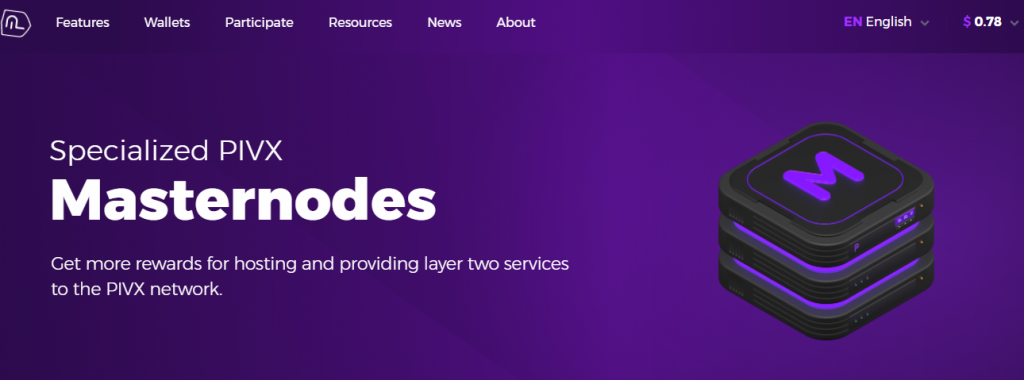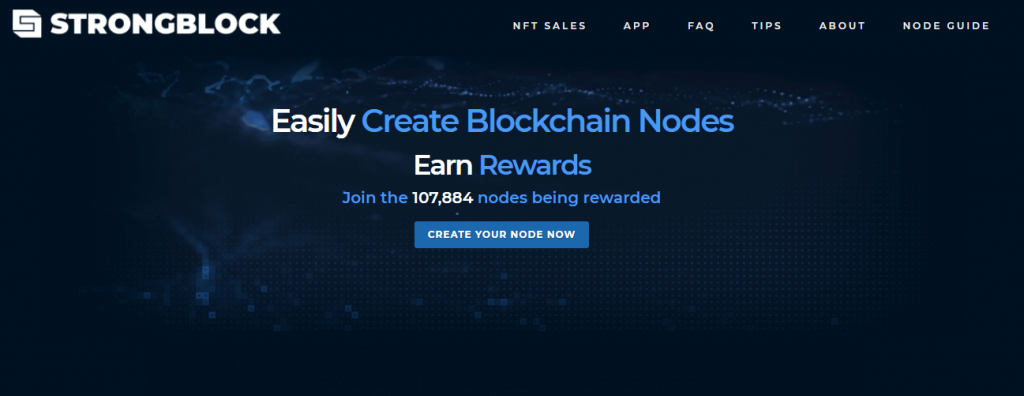
Earning a solid APR on your crypto is hard to do during a bear market. This crypto nodes list will help you find a profitable and low-risk way to get a passive crypto income.
What you'll learn 👉
What Is a Crypto Node?
But, first things first … a little introduction to the whole masternode (hi)story before we deal with crypto nodes that pay money.
Masternodes are special nodes that run a specific software program. They are responsible for validating transactions and securing the network. As such, masternodes earn rewards in return for their services.
Masternodes are similar to cloud mining, except they are hosted locally on your computer or on a rented VPS.
Masternodes are nodes within a network that provide additional services such as validating transactions or serving data requests. In return, they receive rewards in form of transaction fees.
Masternodes are becoming increasingly popular because they offer high returns without investing much time or effort. The best part is that you don’t even need to own a GPU to get started.
The first known masternode project and the most known one is DASH which started the masternode idea and kept popular thanks to it as well.
There are hundreds of other projects that run this masternode model to reach blockchain consensus and we will cover that list of top crypto nodes in the following lines.
Differences Between Mining and Masternode
Mining is the process of using computers to solve complex mathematical problems to validate transactions and generate new coins. Masternodes are nodes that run on top of the network and provide additional services such as transaction validation or governance.
The most obvious difference is that mining requires machines, either GPU or ASIC, even CPU mining (even though it is rare) is still a thing. This means that you would need to purchase these machines with capital, and then would need to sell them when you want to get out. Master nodes require you to only buy a certain amount of the masternode coin, and then you could sell them whenever you want with ease on any exchange.
This allows investors to be a lot more liquid and get in or get out a lot quicker. Another benefit of master nodes is that it requires you to only keep your PC open or use a VPS, which doesn’t spend too much energy. Obviously, mining requires electricity, and in a world that direly needs to go greener, mining has been criticized for a very long time for being an inefficient method.
Read also: Bitcoin Hosting: Best Web Hosting Services That Accept Crypto
What Are the Best Crypto Nodes For Passive Income In 2023?
| Masternode | Cost to Run | Yearly Return |
|---|---|---|
| Dash | $180,000 | $10,000 |
| DeFiChain | $50,000 | $38,000 |
| SmartCash | $500 | $100 |
| Stakenet | $2,000 | $300 |
| Flux | $36,160.75 | $4,000 |
| Stratis | $98,624 | – |
| Syscoin | #33,000 | $1,800 |
DASH
Original Masternode creator DASH has been a popular choice for masternodes for a very long time. It tops the ranks of all “best crypto nodes to run” articles across the web.
Most people made their masternode start with DASH back in the day. Right now it requires over $180k dollars just to have one masternode in DASH and because of this, there are too many people who look elsewhere for a smaller entry to the masternode world.

Anyone who is interested in masternodes and can afford a hefty fee for it ends up having at least one DASH masternode. The entry is #180k but the yearly return is as high as over $10k as well, which makes this masternode one of the biggest passive income earners in the crypto world.
DeFiChain
DeFiChain is one of the best masternode projects out there. It was only launched a little over two years ago, but it’s already generated quite a bit of buzz due to its incredibly high masternode value of almost $50,000 and an impressive yearly return rate of $38,000.
Masternodes on DeFiChain gain rewards approximately every 4 days, 5 hours, and 6 minutes. This may change over time, but is a good indicator for now. In terms of income, masternodes can expect to around 32 DFI in a day and 224.31 DFI weekly.
When this project was first announced, many people were skeptical about the high returns promised by DeFiChain. However, it has gone on to prove itself as a sustainable project with real results behind it – which means that its coin price has kept growing steadily over time. If you’re looking for an exciting masternode project with great potential for growth and rewards, then DeFiChain should definitely be your go-to option!
PIVX
With a cost of near $8k PIVX is preferred more by the people who do not have enough capital to start a DASH masternode. However, PIVX is also one of the best crypto node projects around that brings a good return and has been around for years. It built a great community for itself and brings over $700 a year in passive income for anyone with PIVX masternode.

The liquidity it has also allowed people to get in and out very quickly as well with over $716k volume daily, or nearly 100 masternode worth each day.
DefiChain
Compared to the other two, Defichain is a bit on the younger side, it has been around for just over a year. Yet it did not take too long for DeFiChain to gain attention. With a near $50k masternode value, $38k yearly return, $2.5+ million volume, and $1.2+ billion crypto market cap it created big waves in the masternode world.
At first, the high return was seen as a concern; however, over time it proved to be a decent number, enough to keep the price going up.
StrongBlock
Strong is not a coin itself but a token. It is an ERC20 token that you can buy on Uniswap (it is also available on Kucoin if you want traditional exchanges). You need to buy it and put it on your cold wallets such as a Metamask.

Only 10 of these tokens are required to start one, as of right now it is a little over $600 and requires nearly six thousand dollars to start. However, it also has a 0.1 strong token block rewards as well per day. This means you will earn one node every 10 days.
The fear was that this excess return may cause the price to collapse. However, contrary to the fears, the price has climbed up so far and looks like one of the better profit makers in the storage space so far.
SysCoin
For investing into a SyScoin, you get 5.48% yearly return, which on average is not a bad one, however with a $33k at the time of writing, this means only a $1.8k return per year. Usually small returns, even in passive income, are expected to be a little less capital required, making $100 dollars per year for a $2000 investment could be understood but a big capital as $33k locked for a $1.8k does have its downside.
Nevertheless, SysCoin became such a trusted and beloved coin that there are investors and masternode owners who put their support on top of the profit to make it more appealing for them.
SmartCash
Another small capital masternode in our list is SmartCash. With only a $500 entry and a $100 yearly return, it certainly is one of our list’s better-known and liked masternodes. It has been around for 3 years and has raised some eyebrows with the price changes.

It is one of the more well-known ones because it has good returns, stable prices since 2019, and a high ROI. It is not only for people who want a cheap entry to the masternode world but for those who would like good returns and can afford multiple masternodes altogether.
Firo
Formerly known as Zcoin, Firo is a privacy-focused currency. It uses masternode technology for security and you can hide your transactions in and out of your cold wallets as well. With a little bit over $7k masternode cost and 13% return yearly, it brings in $950 per year passive income while keeping every income hidden from unwanted eyes.
Obviously great for storing income that you do not want others to know, this way you could spend millions and earn thousands without leaving any trace to anyone.
ALQO
Shortly called XLQ, ALQO has been around for over 2 years yet with no Coinmarketcap entry and very low follower number, it is a ghost town of a masternode. It requires only $340 to start and brings in only a $57 yearly return. It is one of the examples of how masternodes are as good as the coin gets. The masternode function can not save a coin without a proper coin itself and get it liked.
By all means, ALQO masternode works as it should and has no problems. Even in that case, it never saw any interest, because outside of the passive income promise, it had no features that people cared about which resulted in its failure.
Phore
One of the oldest projects in the masternode world, Phore started to develop back in 2014. It became public during the 2017 craze and has seen some big interest. They have been around as long as many other options and aside from the famous 2018 bear run fall, the coin kept itself up as well. The cost for one masternode is $800 and the yearly return is as high as $150 as well.

They are focusing on being the masternode coin that ecosystems are built-in. Something that ETH has done for years and saw big success, they would like to repeat it in the node part of the crypto world where investors would reap the benefits of an ecosystem fee usage increase would bring.
Zenon
Starting right after the 2018 bear crash, Zenon has seen only the good sunny side of the crypto world. Aside from the 2021 bear run, it never faced a big crash and brought in a good amount of profit for the investors.
Price not being outside of crypto average ups and downs, with a healthy25% return yearly made Zenon a favorite among investors. Requiring close to $52k for each masternode and bringing $12k APR, it is one of the highest earners for its size.
Stakenet
Last on our list is one of the better-known masternodes in the crypto world as well. Stakenet has been around for years and has been favored by the community. It has a 14% APR and costs a little over $2k to start one, which comes down to around $300 yearly return.

However, what makes it so great is the returns and the safety feeling it gives investors. We have seen coins with great masternodes that failed, we have seen high entry ones that are not inclusive for people with less capital, and ones with low volume.
Stakenet possesses none of these problems, with only $2k entry and a very long-lasting relationship with its community, Stakenet is one that everyone can enjoy together.
The Pros and Cons of a Crypto Node
As we mentioned, Masternodes are a lot more green, saving the environment is as good of a reason as it gets. This is the future of life on earth situation so it is certainly a very important plus for the masternode column.
However it also has that liquidity that doesn’t require anyone to get stuck with machines or codes or anything else, one simple VPS and a starting capital is all you need, or even a PC that can stay open would do instead of a VPS. Passive income without the fear of any machine breaking down, or any unexpected outage is also a great plus as well.
After all, the whole world’s finance revolves around passive income aimed at people. Being richer when you wake up compared to when you went to bed is a good path to becoming a rich person, and masternodes could give you that chance.
If we like to look at the negative part, there is a glaring problem of inflation. If you are running a masternode on a weak coin, the price of that coin could go down, in that case, the amount you made from running a masternode may not be even enough to cover the loss.
So you need to pick your coin to run a masternode very carefully. Even with a proper coin, you could have a bear season and your profits could diminish very quickly. With returns as low as 5% and can go as high as 20-25% for decent ones, it is quite possible to break even or even lose money at the end of the year if it was not a good year for crypto like 2018 was.
Frequently Asked Questions
Read also:
- Best Ethereum Staking Platforms & Pools
- Best Staking Exchanges, Wallets & Services
- Binance Staking Review
- How To Stake ETH 2.0 on Binance? Is It Safe & Worth It?
- What Can I stake on Ledger?
- Tezos Staking explained
- How to Stake on Crypto.com
- How to Stake on Kraken
- How to Stake Cosmos
- How to Stake SNX
- How To Stake On Kucoin?







Look at your Stongblock info again. 10 strong, to open a node. earn 0.1 (actually, 0.09) strong per day. You’re not earning enough to get a new node after 10 days.
10 days = 0.1 * 10 = 1 strong
10 strong / 1 = 10. 10 days * 10 = 100 days.
Need to update pricing again, but good list still!